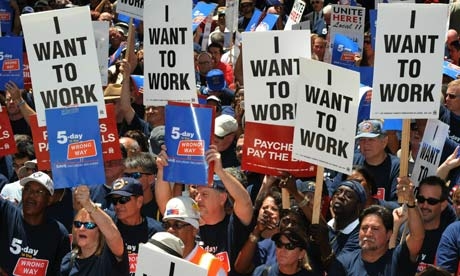
Norway: A Country of Unequalled Equality
As the need for accessibility reform grows in Ottawa, it is important to examine countries that have successfully created effective accessibility programs. In Norway, the government has been busy over the past three years attempting to make the whole country more accessible to persons with disabilities.
On January 1, 2009, the Norwegian government, with the permission of the King, enacted aggressive legislation that strengthened legal protection against discrimination on the grounds of disability. The Anti-Discrimination and Accessibility Act applies to all public areas of society and targets direct and indirect forms of harassment and discrimination towards the disabled, from refusing to hire someone due to a disability or simply neglecting to make a workplace accessible to disabled persons. The Act also requires that public schools allow all disabled students to be given equal opportunities to learn and participate in curricular activities.
This legislation was followed in the same year by a groundbreaking Action Plan put forward by the Ministry of Children, Equality and Social Inclusion. The Plan details the government’s intentions to make Norway universally accessible for persons with physical disabilities.
In order to enact this mammoth plan, the Ministry began collaborating with a large number of other Norwegian government  administrations, including the Ministries of Regional Development, Transport and Communications, Environment and International Development, and the Ministry of Government Administration and Reform. In this way, the accessibility reforms enacted will reach every aspect of public life throughout the country.
administrations, including the Ministries of Regional Development, Transport and Communications, Environment and International Development, and the Ministry of Government Administration and Reform. In this way, the accessibility reforms enacted will reach every aspect of public life throughout the country.
The Act was put forward to be in concordance with The United Nations Convention on the Rights of People with Disabilities, which obliges countries to “implement the necessary measures to ensure that people with disabilities have access to the physical environment, transport, information, communication and other areas and services that are open to or offered by the public.”
Norway plans to increase the number of accessible homes, buildings and outdoor areas by 2025, and ensure that all aspects of Norway’s travel system, including trains, buses and stopping stations, are accessible to disabled persons. Norway is also seeking to improve its information and communications technologies (ICT) network to be entirely accessible to the elderly and persons with disabilities by 2021.
But accessibility isn’t the only concern of the Norwegian government. The Norwegian government has spent nearly a decade enacting legislation prohibiting discrimination based on gender, ethnicity, religious belief and sexual orientation.
In 2006, the Anti-Discrimination Act was passed by the Ministry of Labour, which detailed the government’s commitment to promote complete social equality. The Act prevents any forms of discrimination based on ethnicity, national origin, skin colour, language, religion, belief, sexual preference or sexual orientation. Because of this act, employers can no longer fire, demote, refuse to hire or refuse to promote anyone based on any of the above factors.

One year ago, at the European Forum for New Ideas, Director General Arni Hole of the Ministry of Children, Equality, and Social Inclusion delivered a series of speeches detailing Norway’s commitment to total gender equality.
She emphasized that nations can no longer “afford not to employ all talents from both genders,” and that the world “need[s] women in politics as much as in the corporate world – at all levels.” Hole argued that enabling social frameworks to benefit women and men will build “a more sustainable, fairer and economic[ally] viable society” and that such a society will benefit all involved, “even in strict economic terms.”
The government has enacted a long list of legislation looking to improve the overall equality felt between the two genders. According to Hole: “Sometimes it takes radical affirmative action to produce results and eradicate some of these stern and strict stereotypes.”
Legal protection was offered by the 2003 amendments to corporate laws, requiring every Norwegian company to have 40% of either sex represented on their elected board of supervisors. The amendments accomplished the hoped-for objective: by 2006, an average of 43% of all Norwegian board members were women.
A 2010 study conducted by the Oslo and Copenhagen Business Schools found that the female board members helped make strategic work more efficient by strengthening the board’s capacity-building, developing new competencies and improving conflict management.
These changes to gender representation in Norwegian public and private life have not gone unnoticed. Norway’s legal quotas have been so successful that Spain, the Netherlands, Belgium, France, Iceland and Italy have started enacting their own quotas for gender equality on corporate boards.
However, not all of Norway’s gender reforms were brought about by legislation. Since 1986, every Norwegian Cabinet has had a 40%-60% or greater gender balance. There is no law requiring the Head of Government to appoint a certain number of women to Cabinet, yet every government in the past 26 years has chosen at least eight women to hold ministerial offices.
Seeing the increase in available opportunities, brought about by legislation and public pressure, more and more young Norwegian girls are going to school in order to attain employment they never had access to before. As of 2011, 62% of Norwegian University graduates were female.
Hole also stated that “a quota is not a quick fix.” She believes that in order for gender-equality legislation to be successful, it must be enacted in “a more or less gender-equal society” that gives both genders “opportunities to combine careers and family life.”
Thus, the government sought to improve gender equality by enacting legislation to help parents of young children balance work and home life. Norway’s 1993 Parental Leave Scheme gave fathers and mothers of small children the right to leave work early in order to pick up their child from daycare or preschool. These parents also have the right to refuse to work overtime when no one is available to take care of their children.
This legislation has improved the overall status of parents and families in Norway. Save the Children’s 2012 State of the World’s Mothers Report placed Norway as the best country in the world in which to be a mother, with Canada ranking 19th and the US ranking 25th.
On MSN’s 2012 list of the top 10 countries to live in, Norway ranked second. Canada previously held the second-place rank, but sank down to sixth place in the past year. The ranking is based on the Organisation for Economic Co-operation and Development (OECD) Better Life Index, which creates reports and rankings on developed nations based on overall population satisfaction. As of 2012, the index reported that there is a higher per cent of the Norwegian population reporting to be employed, volunteering in community activities, contributing to environmental efforts, managing work-life balance, and feeling more satisfied with their overall quality of life than in those reporting in Canada. Canada still ranks higher in housing availability, income earned, quality of education, quality of health care and overall safety in public life.
But these statistics don’t lie, as in the past year alone, Norway has seen a substantial increase in labour migration, as tens of thousands of immigrants moved to the country looking for work, many of them with their families.
According to Hole, the government strives to be as transparent as possible, placing all public hearings online and opening Ministerial journals to the public. All social reforms are always subject to consultation and public hearings before being voted on in Parliament.
All private and public businesses are required to submit annual reports to the government detailing the status of social equality in their workplace. The government responds with measurements and evaluations based on the information submitted. Such “transparency” and “exposure,” says Hole, keeps companies and government accountable to the commitment to social equality and thus promote “sound economics,” as well as “a moral base [with] equal opportunities for all individuals.”
Hole believes that Norway needs to continue to “develop a society better prepared for future challenges in terms of demographic changes, economic competitiveness, employment, social sustainability and human rights.” Hole and the Norwegian government claim that all individuals should have equal access to all sectors of society, regardless of race, gender, sexual preference, religious belief or disability.
By giving equal opportunity to all individuals, at the workplace, in school, in government, and even through public transportation and building accessibility, Norway seeks to enable to ensure that those with high competencies, unique talents, creative minds and indomitable spirits are never hindered in any aspect of their daily life.
This includes the disabled and handicapped, as preventing even one person from being able to enter a building or travel to work runs the risk of preventing someone with inimitable aptitude from contributing to the betterment of their country.








